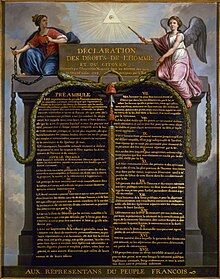 The
year 1789 was an important year for human rights, first producing the Bill of
Rights in the United States constitution, followed a few months later by the
French's own official penning of the rights of the men of their country, titled
The Rights of Man and of the Citizen. It followed the storming of Bastille by
the citizens, and was introduced into the general assembly that only a month
before had abolished feudalism. The document was introduced by Lafayette, and
was greatly influenced by Thomas Jefferson, whom the general had worked with
during the American Revolution.
The
year 1789 was an important year for human rights, first producing the Bill of
Rights in the United States constitution, followed a few months later by the
French's own official penning of the rights of the men of their country, titled
The Rights of Man and of the Citizen. It followed the storming of Bastille by
the citizens, and was introduced into the general assembly that only a month
before had abolished feudalism. The document was introduced by Lafayette, and
was greatly influenced by Thomas Jefferson, whom the general had worked with
during the American Revolution.
The
document is relatively straightforward, with a short forward emphasizing that
the document was written by the representatives chosen by the people, deriving
its authority by the rule of the masses. I goes on to accuse government
corruption on ignoring the following human rights, which it strongly proclaims “inalienable”.
It is interesting to note that despite the emphasis on the right of man in the
forward, the document itself is primarily concerned with the rights of the
citizen, and what the government cannot stop or force the citizen to do.
The
nature of the document is very secular, disassociating religion except for a
brief message that no citizen could be silenced for their opinions, including their
religious views. Other than that, it goes into detail how the people can’t be
treated by the government- no silencing opinions, no undue arrest, no property
seizure, no abuse of public military, no unequal taxes, and the list goes on.
It is obvious in the rhetoric that the writers were very concerned with how the
government could abuse the people, and the wording itself makes the reader wary
of an overreaching body of power. In fact, the only concessions given to the
government is that fairly passed laws must be followed, and individual citizens
in the governments employed were accountable for their actions on the government’s
behalf. The documents even limits the laws that can be made- laws could only be
passed if they limited harmful behavior towards society, and nothing not in law
could be required or prohibited of their citizens.
The
document is worded in a way that would really get the general people behind it,
written in a straightforward manner painting the government as a necessary evil
that they should work to limit, which fits well with the spirit of the early
French Revolution.
From your description, it sounds very much like a legal document. Which is fitting given its very nature :) I mean that its tone must be very articulate and precise in phrasing the conditions and declarations contained therein. It sounds like they did a good job of catering the document to more legal audiences and very educated citizens. It makes me wonder, however if it really is just intended for the educated and lawyers? Did you feel like it could have been understood by the general public?
ReplyDeleteIt's interesting to see how this document and the Declaration of Independence--both documents continuing, not starting, a revolution--both contain this oh-so-attractive ideal of equality for all and small government. More interesting is to see how the ideals in these similar revolutionary documents have morphed over time. The French government obviously has quite a bit of control over certain things, and the immigration problems in France make it difficult to have equality. The U.S. has the same type of problems.
ReplyDelete